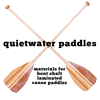laminated bent shaft wood canoe paddle building FAQs
Everybody has'em as the saying goes. Funny how doing something for the first time tends to bring out basic issues that prove surprisingly hard to answer. Below are some of the questions that have been asked and then figured over the years in the world of hand-powered wood working and canoe paddle building. In the DIY world, quite often there are no definitive answers. There are opinions and preferences, most often based on experience. You need to make your peace with that and instead of relying on someone else's answer, you do your own research, decide on what you think is right and go about gathering your own experience.
